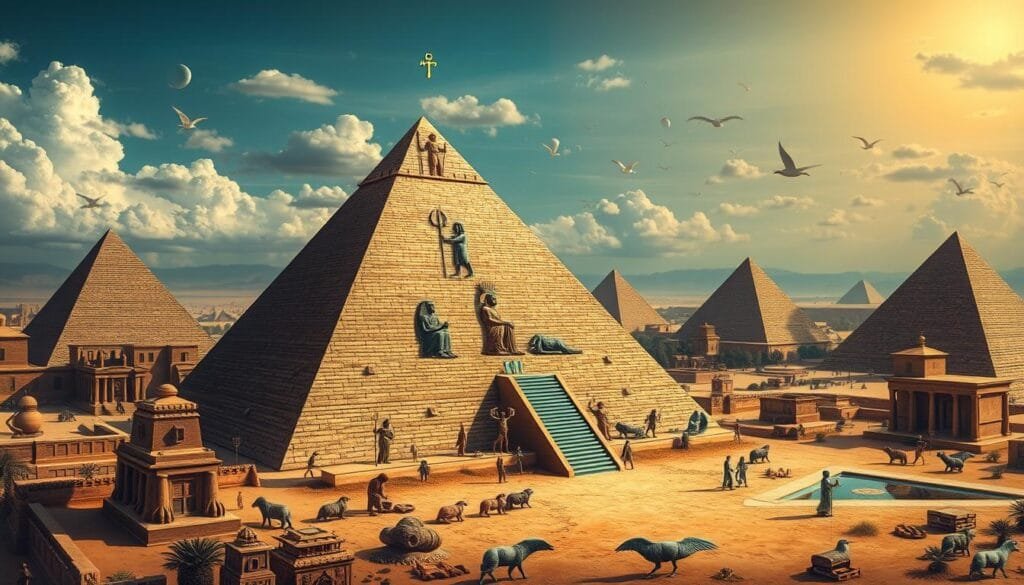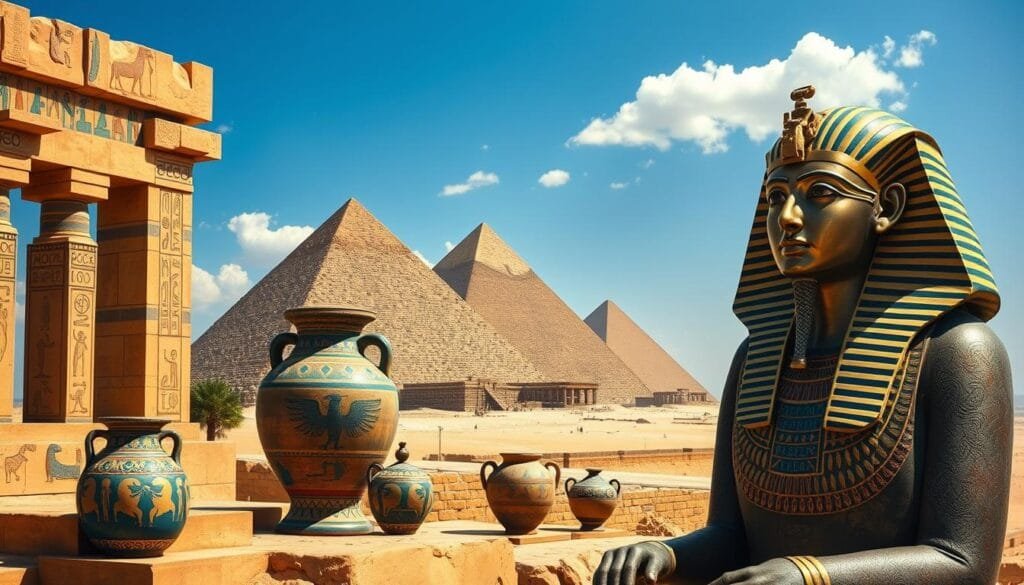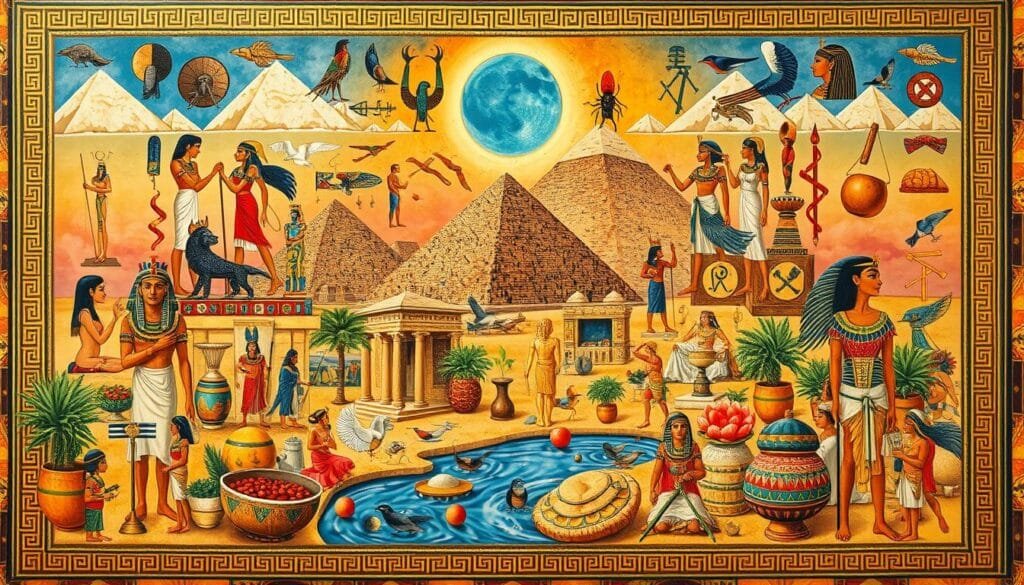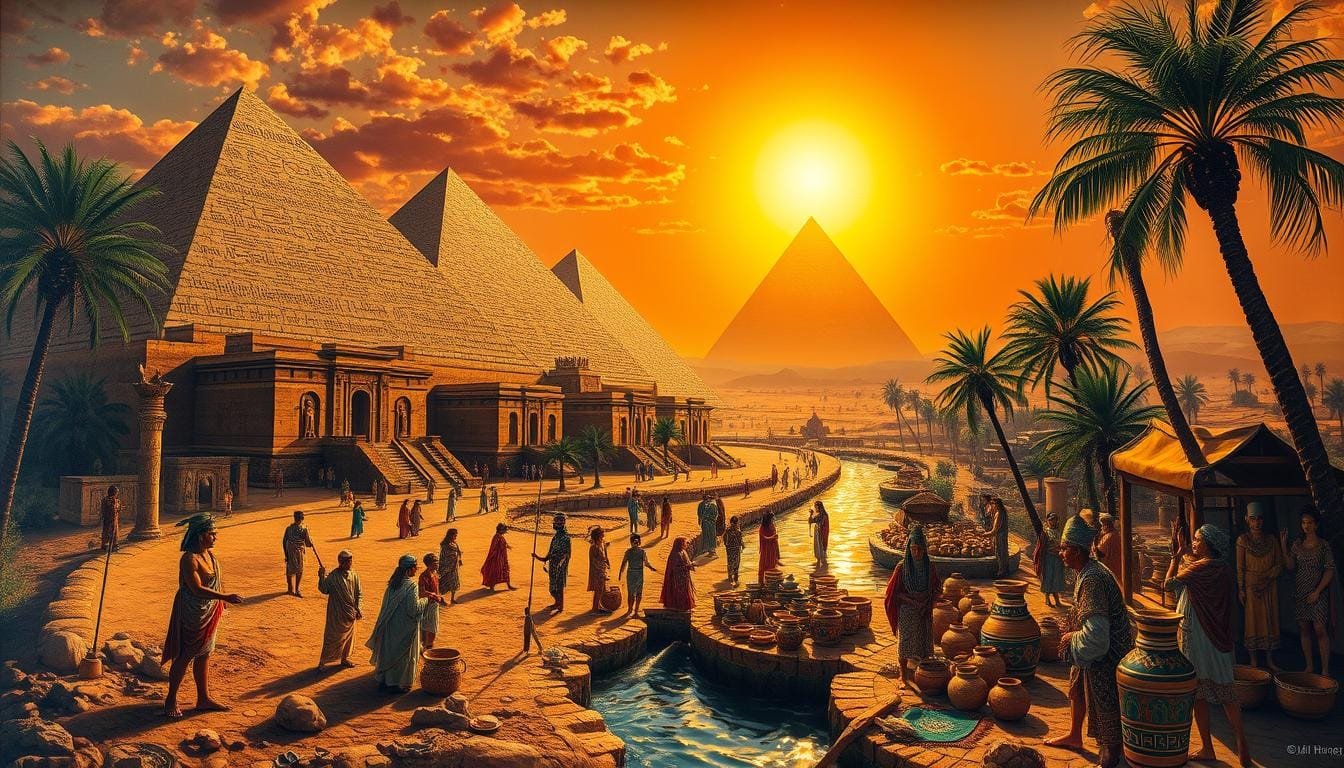Imagine learning about ancient Egypt’s lifestyle and traditions as more than just facts. When making an Egypt culture PPT, it’s important to connect the past and present in an engaging way. Have you thought about why ancient Egyptians focused so much on mummification and grand temples, or how the everyday Egyptian lived? By exploring their traditions, homes, clothes, and religions, we uncover what made their civilization so fascinating.
Looking into Egypt’s traditions adds to our knowledge and connects us to our cultural roots. Marriage customs, food, religious beliefs, and major gods and goddesses all offer clues to the bigger picture of ancient Egyptian life. Also, the practice of mummification shows how much they valued the afterlife. This journey into the past lays a strong foundation for your presentation on Egyptian heritage.
New discoveries and research shed more light on ancient Egypt’s lasting legacy. Our journey takes us beyond history to understand their social order, daily activities, and incredible architecture. This gives a lively picture of their civilization.
Are you ready to dive into this exploration? Let’s discover what made ancient Egyptian culture and traditions stand so strong.
Key Takeaways
- The cornerstone of an engaging Egypt culture PPT is bridging historical facts with relatable narratives.
- Exploring marriage customs, food preparation, and religious beliefs enriches our understanding of traditions in Egypt.
- Key deities such as Re, Anubis, Osiris, and Isis reveal the complexities of ancient Egyptian religion.
- Everyday life in ancient Egypt offers valuable insights into housing, occupations, and social structures.
- Monumental architectural achievements, such as the pyramids and temples, underscore the ingenuity of ancient Egyptian builders.
- The practice of mummification highlights the civilization’s deep connection with the concept of the afterlife.
- Embracing the comprehensive cultural heritage of Egypt offers a more vibrant and layered historical perspective.
Understanding Ancient Egyptian Religion
The Ancient Egyptian religion was rich and important in their daily lives. It featured many gods, complex rituals, and a deep belief in the afterlife. Let’s dive into the beliefs and customs that marked their spirituality.
Polytheism and Major Deities
Egyptians honored a lot of gods, with each one playing a special role. Amun was known as the ‘King of the Gods,’ showing his key place in their worship. Anubis looked after embalming and the dead. Osiris ruled the underworld and was the god of resurrection. The sun god Ra was about life and death, being reborn every day. Ma’at stood for truth and justice, which shows how much they valued balance. Different regions had their own gods, showing diverse practices across Egypt.
Temple Structures and Rituals
Temples were central to religious life, acting as homes for gods and places for complex rituals. They were big and beautifully decorated, reflecting the gods’ home on earth. Pharaohs connected the people and the gods and did rituals to keep harmony and win the gods’ favor. Every ritual was planned carefully, showing their deep respect and love for their gods.
Religious Practices: Mummification and Burial Customs
Belief in the afterlife led to detailed burial customs and mummification. Pharaohs and nobles were buried with their servants, showing a clear social order even in death. Records show that King Aha was buried with 41 servants, King Djer with 587, King Djet with 236, King Den with 230, and King Qaa with 30. This shows how widespread this practice was.
Mummification was done with great care, preparing the body for the afterlife. Bodies were wrapped, plastered, and put in coffins. Canopic containers kept organs safe. Amulets provided spiritual protection. Pharaohs’ tombs had everything they might need in the next life, showing the role of possessions in their beliefs.
The Social Hierarchy in Ancient Egypt
Egypt’s social hierarchy was complex but crucial for shaping their society. At its heart was the Pharaoh, seen as a god-like ruler. Different social levels, from nobles to slaves, each had unique roles in daily life. Let’s explore how this system worked and affected people every day.
The Role of the Pharaoh
The Pharaoh was key in ancient Egypt, acting as a god on earth with total control. They oversaw religion, the military, and ruling the land. Beneath the pharaoh was the Vizier, tasked with handling the state’s affairs. This setup was essential for keeping order and starting big projects, like building pyramids.

Social Classes and Occupations
Social classes in Egypt were well-defined, each with its duties. Nobles were at the top, able to work in government. Then came the scribes, boys trained from young ages to manage records. Farmers, who paid a lot of their harvest in taxes, were the economy’s heart. Traders sold artisans’ goods, while soldiers fought or supervised laborers. Slaves included war captives and debtors.
Daily Life and Community Structures
Your place in society shaped your day in ancient Egypt. For example, farmers’ work depended on the Nile and its floods. Craftsmen and artisans boosted the culture and economy with their work. Though hard, moving up in class was possible for some, affecting education and housing. Most homes were built high near the Nile to avoid floods.
Learning about Egypt’s social system, the Pharaoh, and everyday life shows us the depth of this ancient civilization. Despite their strict class system, Egyptians built a lasting and impactful society.
Exploring Egyptian Art and Architecture
Ancient Egypt, existing from 5000 BC to nearly 300 BC, leaves us in awe with its art and architecture. Its long history shows great advances in architecture, art, and the crucial role of hieroglyphics.
Significance of Hieroglyphics
Hieroglyphics lasted nearly 3,500 years in ancient Egypt. They were more than a writing system; they helped us understand their culture and communication. Used on tombs, temples, and monuments, they merged art with language. These symbols connected daily life to the spiritual world. They preserved stories, religious beliefs, and historical events for generations.
Pyramids and Monumental Builds
The Great Pyramid of Giza is a prime example of hierarchical architecture. Built with about 2.3 million blocks, each one weighing 2.5 tons, it shows ancient Egypt’s architectural genius and strong workforce. These great structures were not only royal tombs but also symbols of power and religious faith. They demonstrated the Egyptians’ advanced engineering and their ability to use vast resources.

Artistic Representations in Tombs and Temples
Most Egyptian art, about 90%, had religious themes. Tombs and temples featured detailed paintings and reliefs showing gods, goddesses, and daily life after death. Well-known gods like Ra, Osiris, and Horus were central in these artworks, reflecting the culture’s many gods. Sculptures often showed people in ideal forms, like the common stance with the left foot forward. This art was crucial for keeping the dead’s comfort and identity in the afterlife, showing its deep spiritual and cultural importance.
In summary, Egyptian art and architecture give us a glimpse into a society that recorded their world with impressive buildings and the important use of hieroglyphics. Their grand buildings and detailed art still fascinate us, teaching us about their amazing civilization.
Advancements in Science and Technology
The ancient Egyptians were trailblazers in many scientific areas. They made incredible strides in medical practices, astronomy, and engineering. Their efforts formed the basis for numerous modern advancements.
Medical Practices and Innovations
Ancient Egyptian doctors were ahead of their time, especially in medicine. They mixed magic and real remedies to treat illnesses they thought were caused by gods. They knew a lot about the human body, leading to innovations like surgeries and pregnancy tests. By the fifth century B.C., they had specialized medical fields and even served in royal courts. Importantly, they were some of the first to record their medical knowledge, greatly influencing today’s medicine.
Astronomy and Calendar Systems
Egyptian astronomers were also priests who monitored the stars. For example, Sirius’s rising signaled the life-giving flood of the Nile. This observation helped them create a 365-day calendar that divided the year into 12 months. These months were split into three seasons with ten-day weeks, crucial for farming and celebrating festivals. The New Year on July 19 started the flood season (akhet), followed by growth (peret) and harvest (Shemu).
Mathematics and Engineering Feats
The pyramids show the ancient Egyptians’ engineering genius. Building the Great Pyramid at Giza required around 20,000 workers over 20 years. Covering 13 acres, it consists of about 2.3 million limestone blocks, each weighing 2.5 tons. Its precise alignment and the uniformity in side length are remarkable feats of engineering.
They also excelled in mathematics, using the Horus Eye Fraction System for complex calculations. Their metalwork, through mining gold, copper, iron, and bronze, was crucial to their economy.
These achievements highlight ancient Egypt’s role in shaping science, astronomy, and medicine. Their innovative spirit paved the way for future scientific and technological breakthroughs.
Creating What is Egypt Culture and Traditions PPT
Creating a presentation on Egypt’s culture and traditions is exciting. It’s key to structure it well to keep everyone interested. We cover everything from ancient rituals to grand monuments. Each slide should bring Egypt’s history to life, using visuals and key points effectively.
Structuring Your Presentation
Creating a clear flow is critical from the start. Begin with an intro slide about Egypt’s culture. Then, cover topics like religion, social order, art, and science. Start each section with a slide summarizing what you will talk about.
In the religion section, for instance, mention time periods like the Archaic and Roman periods. This helps organize the presentation clearly. It makes it easy for the audience to follow along.
Incorporating Visuals and Charts
Visual aids hugely boost engagement. Use images and charts to simplify information. A picture of the Giza Pyramids or the Egyptian Museum increases interest. A chart of the social structure, highlighting the Pharaoh and his officials, is also helpful.

This approach grabs the audience’s attention. For example, an infographic on mummification shows the process vividly. It shows that bodies were preserved in natron for 70 days.
Key Points to Highlight
It’s essential to focus on what makes Egypt’s culture unique. Talk about the Nile Culture starting in 3900 B.C.E., the discovery of 130 pyramids, and gods like Osiris and Isis. Sharing that 24% of commoner marriages were between siblings will intrigue the audience.
Also, discuss Cleopatra’s alliances with Julius Caesar and Mark Antony. Mention that the Giza Pyramid complex is recognized by UNESCO. These fascinating facts make a memorable presentation.
To make a great Egypt culture PPT, structure it well and use engaging visuals. This will bring the ancient world right into the room.
Conclusion
As we wrap up our journey into ancient Egypt, we find a rich history full of tradition and innovation. This culture has made a lasting impact on the world. Ancient Egypt covers over 3,000 years with its complex society and scientific achievements.
When you make your Egypt Culture & Traditions PPT, focus on the main points. Talk about the role of religion and the Pharaoh. Don’t forget their scientific and technological leaps. Use pictures and charts to make your slides more engaging and clear.
Thinking about Egypt makes us appreciate its remarkable legacy. The pyramids and the Palermo Stone show a society connected to its beliefs, nature, and leaders. In your presentation, highlight these aspects to showcase ancient Egypt’s impact on our world today.
FAQ
How can I start creating my Egypt Culture & Traditions PPT?
Start by researching everything about Egyptian culture, traditions, and heritage. Organize your presentation to highlight areas like religious practices, social ranks, and science and technology breakthroughs.
What are some important topics to include in an Ancient Egyptian Religion section?
Important topics include the belief in many gods and the main gods, the design and function of temples, and their religious customs like mummification and burial rites. Use terms such as “Ancient Egyptian religion,” “Egyptian deities,” and “mummification customs” to improve SEO.
What is the significance of the Pharaoh in the social hierarchy of ancient Egypt?
The Pharaoh was seen as the supreme leader and almost a deity in ancient Egypt. They were key in governing and religious acts. It’s vital to talk about the Pharaoh’s role, social classes, and everyday ancient Egyptian life.
What are key elements to discuss in Egyptian art and architecture?
Discuss the importance of hieroglyphics, why pyramids and big buildings were built, and the art in tombs and temples. Mention “Egyptian art,” “hierarchical architecture,” and “the importance of hieroglyphics” for SEO optimization.
What advancements in science and technology were made by ancient Egyptians?
The ancient Egyptians made great strides in medical practices and inventions, studying stars and creating calendars, and in math and building techniques. Highlighting these achievements is essential.
How should I structure my What is Egypt Culture and Traditions PPT?
Begin with an intro to Egyptian culture and traditions. Then break it down into detailed parts on religion, social structure, art, architecture, and scientific contributions. End with a recap. Adding images and charts will make it more engaging.
What are some key points to highlight about Egyptian heritage in my presentation?
Emphasize the complex nature of Egyptian culture, the impact of religion, the class system, technological and scientific breakthroughs, and the enduring influence of their art and architecture. Use visuals and charts for more impact.
